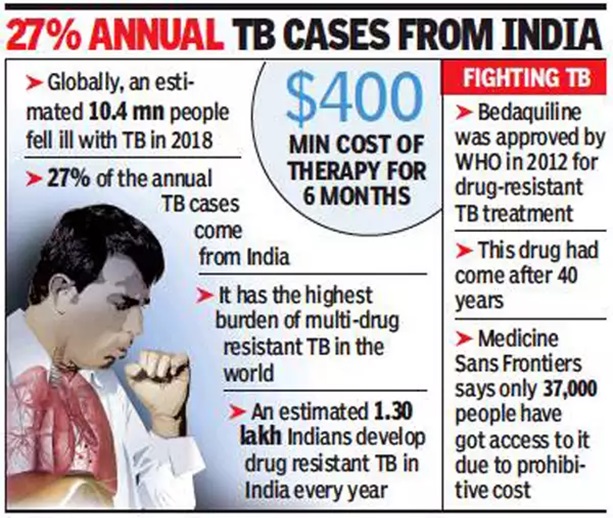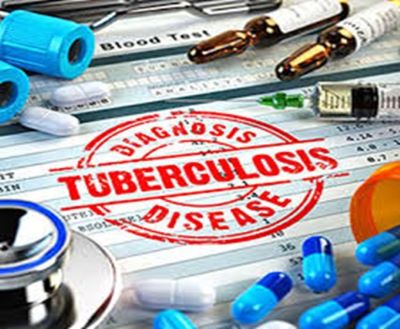Context-
Tuberculosis (TB) has left an indelible mark on human history, finding mention across various historical accounts and literary works, a testament to its long-standing affliction on societies worldwide. Even today, TB remains a major global health issue, with India bearing over a quarter of the global burden. While significant progress has been made, driven by political will and concerted efforts, much more needs to be done to achieve the goal of TB elimination. As Prime Minister Narendra Modi has urged, it is crucial to employ innovative approaches and leverage proven technologies to eradicate TB from India.
Addressing the Challenge of 'Missed' TB Cases
India has made notable strides in recent years. In 2023, the country diagnosed 25.1 lakh TB patients, highlighting a strengthened effort to identify 'missed' TB cases — cases that might otherwise have gone undetected due to underreporting or diagnostic gaps. However, as we advance toward the ambitious target of TB elimination, it is imperative to explore new strategies and utilize effective tools that can help achieve this goal faster.

● Reforming Drug-Resistant TB Treatment Regimens
One of the most urgent priorities in India's anti-TB strategy should be investing in shorter, more effective treatment regimens for drug-resistant TB. The current regimens, while effective to an extent, are long and arduous. For example, patients on the shorter nine to eleven-month regimen are required to consume nearly 13 to 14 tablets daily, while those on the extended 18 to 24-month regimen must take four to five tablets per day. These regimens can be physically and psychologically draining, with severe side effects such as hearing loss and psychosis.
● The Case for Shorter Regimens
The extended treatment period poses additional challenges. Frequent visits to TB clinics over a span of up to two years can result in significant loss of employment and income, driving many families into poverty. Recognizing these issues, the World Health Organization (WHO) recommended in 2022 a shorter, safer, and more effective regimen known as BPaL/M for all drug-resistant TB patients. This regimen has demonstrated higher success rates and better patient compliance, requiring only three to four tablets per day for a duration of six months, with minimal side effects.
Global Adoption and Cost Benefits
Globally, approximately 80 countries have already procured the BPaL/M regimen, and about 20 of the highest TB burden countries have begun rolling it out. Research indicates that transitioning to the BPaL/M regimen could result in savings of 40% to 90% compared to current treatment costs. An immediate shift could lead to annual savings of about $740 million (approximately ₹6,180 crore) for health systems worldwide. Given its effectiveness and cost benefits, India must expedite access to the BPaL/M regimen for all eligible patients.
● Enhancing TB Diagnosis with Advanced Tools and Techniques
While new treatments are crucial, an equally important aspect of India's anti-TB strategy involves diagnosing more people with TB, ensuring that they can benefit from these game-changing regimens. This requires modernizing our approach to TB detection and employing more proactive, data-driven methods.
● Proactive Screening and Early Detection
A key step is to utilize health datasets, including Geographic Information System (GIS) mapping, to identify vulnerable populations. This includes people with comorbidities like malnutrition, diabetes, and HIV, former COVID-19 patients, and at-risk communities such as those living in slums, prisons, or experiencing homelessness. Targeted multi-disease screening drives can be conducted to detect TB cases early, even among those who may not exhibit typical symptoms like cough, fever, weight loss, or night sweats.
● Leveraging Technology for Early Diagnosis
Recent evidence underscores that a significant number of pulmonary TB cases may not present recognizable symptoms. The National TB Prevalence Survey (2019-21) found that chest X-rays detected 42.6% of cases that would otherwise have been missed. Using portable X-ray machines equipped with artificial intelligence (AI) tools can significantly reduce diagnostic delays, particularly in remote and under-resourced areas. Additionally, there is a critical need to expand the use of rapid molecular tests, which are more sensitive than traditional microscopy methods. This shift will enable faster detection of TB cases and accurate drug resistance profiling, facilitating appropriate treatment.
● Expanding Access to Game-Changing Treatments
With new, more effective TB treatments becoming available, India must prioritize efforts to expand access to these regimens. The introduction of the shorter BPaL/M regimen for drug-resistant TB marks a significant advancement in TB care. However, ensuring its widespread adoption will require strong political will, adequate funding, and robust public health infrastructure.
● Ensuring Accessibility and Affordability
The government must work to ensure that all eligible patients, particularly those in marginalized and underserved communities, have access to these new treatments. This may involve subsidizing the cost of the BPaL/M regimen or integrating it into existing health programs. Collaboration with private sector partners, non-governmental organizations, and international health bodies can also play a critical role in scaling up access and ensuring affordability.
● Strengthening the Health Infrastructure
For India to succeed in its TB elimination mission, it must continue to strengthen its health infrastructure. This includes expanding diagnostic capabilities, enhancing laboratory networks, and improving the supply chain for TB medications and diagnostic tools. Training healthcare workers and community health volunteers on the latest TB diagnostic methods and treatment protocols will also be vital in ensuring high-quality care and improving patient outcomes.
● Fostering Community Engagement and Awareness
In addition to strengthening the health infrastructure, fostering community engagement and raising awareness about TB is crucial. Many TB patients delay seeking treatment due to stigma or lack of awareness about the disease. Public health campaigns, leveraging mass media and digital platforms, can help to educate the public about TB, its symptoms, the importance of early diagnosis, and the availability of effective treatments. Community-based initiatives, such as engaging local leaders, health workers, and volunteers, can also play a key role in destigmatizing TB and encouraging people to seek timely medical care.
Conclusion
India stands at a critical juncture in its fight against tuberculosis. With the availability of new, game-changing treatments, there is a unique opportunity to significantly advance toward the goal of TB elimination. However, achieving this goal will require a multi-pronged approach that includes adopting shorter, safer, and more effective treatment regimens, enhancing diagnostic capabilities, and expanding access to care for all patients. By prioritizing these essential areas, India can ensure a healthier future for its citizens and make significant strides toward becoming TB-free.
As the Prime Minister has called upon the nation to work towards TB elimination, it is time to redouble our efforts, leverage the latest technologies, and make strategic investments in our health infrastructure. Only through a comprehensive and sustained effort can we hope to eliminate TB and free future generations from this debilitating disease.
|
Probable Questions for UPSC Mains Exam- 1. What are the potential benefits of adopting the WHO-recommended BPaL/M regimen for drug-resistant TB in India, and why is it considered a better alternative to the current treatment regimens? (10 Marks, 150 Words) 2. How can the use of advanced diagnostic tools and data-driven approaches enhance TB detection and improve treatment outcomes in India? (15 Marks, 250 Words) |
Source- The Hindu







